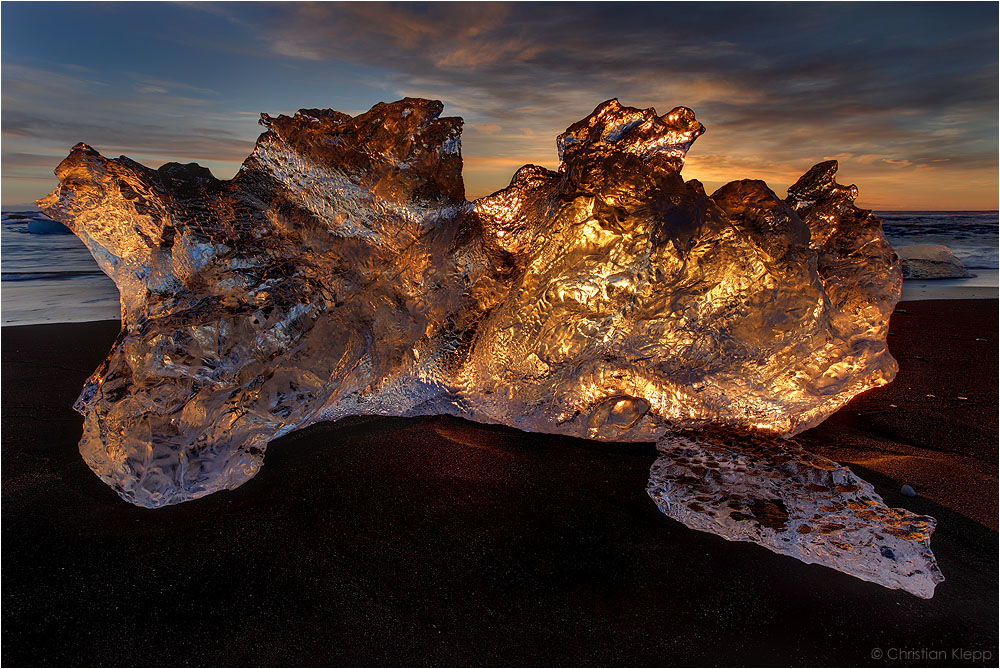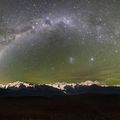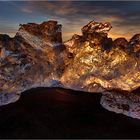Eis Nugget
Zwei jeweils weniger als einen Monat andauernde Perioden im Sommer und Winter bieten auf Island ideale photographische Bedingungen. Dies sind die Mitternachtssonne im Zeitfenster um den 21. Juni und die tiefe Wintersonne um den 21. Dezember. In beiden Fällen steht die Sonne stundenlang am Horizont und bietet endlose Sonnenauf- und Untergänge mit spektakulären Licht-bedingungen. Dabei steht die Sonne im Winter am Südhorizont, während sie im Sommer am Nordhorizont steht. Diese 180° Drehung des tiefen Lichtstandes beleuchtet die Landschaften Islands auf jeweils ganz eigene, einzigartige Art und Weise. Der Strand der Gletscherlagune Jökulsárlón des Vatnajökull weist mit Blick auf den Nordatlantik Richtung Süden. Dadurch verursacht die tiefe Wintersonne ein einzigartiges Natur-schauspiel wenn sie hinter den gestrandeten Eisbergen aufgeht, und diese von hinten beleuchtet. Jede einzelne Fläche im Eis reflektiert das Sonnenlicht in eine andere Richtung, wodurch die Eisberge auf dem tief-schwarzen Basaltsand des Strandes wie Diamanten funkeln. Da der starke Tidenhub des Nordatlantiks die Eisfläche der zugefrorenen Gletscherlagune am Ausfluss zweimal täglich aufbricht, gelangen auch im Winter genug Eisberge in den Ozean und damit an den Strand.
January 2011
Canon 5D MkII, Canon L 16-35 mm, f/16, 0.3 sec, ISO 50, Lee GND, tripod
Mehr Information:
www.lichtjahre.eu
Where Geoscience Meets Art
_____
Two short periods of about three weeks in summer and winter offer perfect photographic conditions on Iceland. These are the midnight sun around the 21st of June and the low winter sun around 21st December. Both periods are characterized by low sun elevations for hours resulting in spectacular lighting with endless sunrises and sunsets. In summer the sun encircles the northern horizon while it lights up the southern horizon in winter. This 180° shift of the low light uniquely illuminates the Icelandic landscapes. The beach of the glacier lagoon Jökulsárlón at Vatnajökull heads south towards the North Atlantic Ocean. This causes a natural spectacle when the sun rises behind the beached icebergs by illuminating them from behind. Each crystal plane of the ice reflects the sunlight into a different direction causing the iceberg to sparkle like a diamond on velvet on the pitch-black basaltic sand of the beach. The strong tidal currents of the North Atlantic break up the frozen surface of the glacier lagoon twice daily. Compared to summer this still allows a reduced number of icebergs to float into the ocean and getting beached at low tide.


























Eve 26/10/2012 20:10
Fast wie Feuer und Eis - wunderschön schaut's aus :)LG Eve
Sue Bürger 09/03/2012 12:43
Hammerbilder zeigst Du hier - gigantisch! Und schon wieder so viele Infos - DANKE! LG SueMichaela St 10/12/2011 11:56
Sprachlos - und das passiert selten ;)optimist43 30/10/2011 16:50
einfach toll, Gruß, HelmutHerma Jacob 30/10/2011 16:41
sehr festlich! :)Christoph Prall 30/10/2011 16:39
Hammer Arbeit !!ciao Chris
Roland Klecker 30/10/2011 16:38
Einfach nur grandios!Eine Schande, dass es nicht in die Galerie gekommen ist!
Liebe Grüße,
roland
Michael Kripp 30/10/2011 16:30
FantastischEifelpixel 30/10/2011 16:23
Wahnsinn was man alles Fotografieren kann wenn man des Wissen der Umstände hat.Sieht super aus.
LG Joachim
Philehipp 30/10/2011 16:23
Im ersten Moment dachte ich , das wäre Alu-Folie, die sehr gut inszeniert wurde, dann aber hab ich die Geschichte gelesen und bin ehrlich von Grund auf Begeistert ... Sehr schönHoney™ 30/10/2011 16:13
sieht richtig mega toll klasse ausrudi roozen 30/10/2011 16:13
Danke für die sehr dienlichen Hintergrundinfos.Das Bild ist großartig und begeistert.
LG Rudi
Rainer Arenz 30/10/2011 16:09
Wow, super FotoGruß Rainer
Daniel Pfarr 25/08/2011 20:15
geniale bilder, respekt. in diesem beruf kann man das hobby fotografieren ja auch wunderbar integrieren.erinnert mich etwas an salvador dali
gruß
daniel
Untertaucher der Erste (Picasa) 24/08/2011 9:06
Meisterhafte Inszenierung